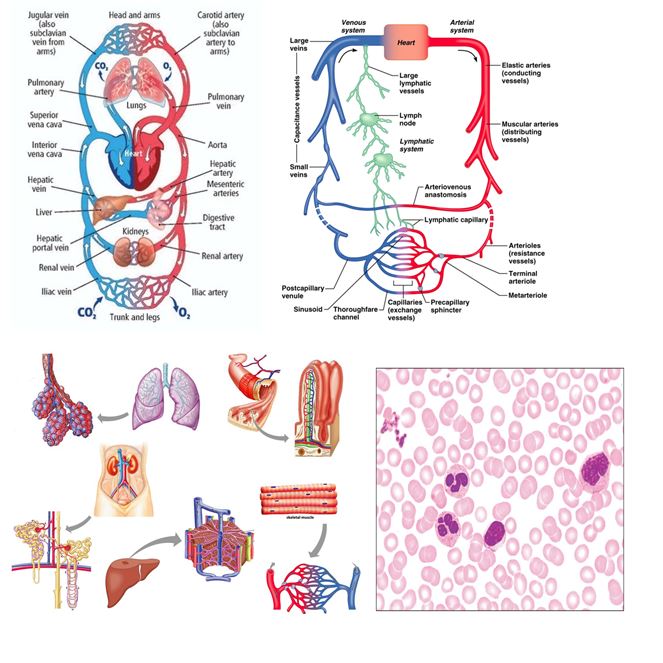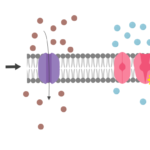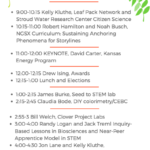A Thematic Approach to Anatomy and Physiology
I recently had an exchange with some area teachers about how we approach the curriculum of a high school anatomy and physiology course. My course (and entire practice) is always undergoing change and revision. That said, I’ve created an outline for my course that might be helpful for others who are considering an attempt to escape the vocabulary grind of a legacy A&P classroom.
The students and I work the entire semester at developing their competency at telling the ‘story’ of a single anatomical theme instead of grinding through a linear sequence of discrete curricular units and a series of independent point-driven tasks. While not strictly PBL as it is commonly described, students are accountable for developing and presenting a cohesive, thematic schema for what they know as a result of our work together.
So here is an outline of what we’ll be attempting this year. If you’re walking a similar path in your classroom, be sure to share out your questions, suggestions, and comments.
_______________________________________________
Fall Semester – Thematic Development of Curricular Standards
Theme: Environmental Interactions – Your Brain is a Survival Organ
Your heart pumps blood. Your lungs breathe air. Your skeleton provides structure, support and protection. Your muscles produce movement. But what about your brain?
Your brain is a survival organ that regulates your internal physiology within relatively narrow limits and guides your environmental interactions to maximize homeostasis (health). Biologically, humans are habit-driven, emotional beings who have the capacity for cognition (thinking, self-awareness). Our brain’s function is to continually respond to the dynamic environment in which we live enabling us to avoid threats, seek opportunities, and utilize cognition so that we may assert greater levels of control within that environment. We are a bundle of habits, emotions and thoughts, and we can act in response to all three.

Thematic Development: Lower Order and Higher Order Interrelationships
The lower order and higher order parts of the brain do not operate independently of one another. The brain stem, diencephalon, basal nuclei, limbic system, and cerebral cortex have established numerous neural and hormonal interconnections through which they influence one another in such a way that they are able to warn of potential threats in the environment and reward successful interactions with the environment. The amygdala (warning) and the septal region (reward) play a significant role in learning and knowing, the amygdala at the beginning of the process (learning) and the septal nuclei and nucleus accumbens at the back end (knowing).
Thematic Development: Learning and Knowing are NOT the Same Thing
The functional interrelationships between higher order regions of the brain are such that learning and knowing take place as related, but distinctly different, processes. An individual’s cognitive belief system and self-concept impact every aspect of the learning and knowing processes. Mindset, in particular, functions as a ‘system override’ that acts to habitually accept or reject new learning in ways that can either enhance the receptivity to new information, or dramatically close off access to the learning and knowing pathways within the brain.
Thematic Development: Motivation
Humans don’t have to be motivated to learn, learning is the motivation. Cognition is a powerful survival adaptation for interacting with one’s environment. Our brains contain an internal frame of reference, so that success in thought leads to heightened levels of control which we ultimately experience as competency and gratification. The brain has evolved to learn, and so it should be no surprise that cognition leading to greater control is ‘hardwired’ into the brain’s internal reward system. All motivation can be explained in terms of environmental interactions that lead to the feeling of well-being and competency.
Thematic Development: Joints and Movement – Bones, Muscles and Nerves
Moveable joints have fundamental structural and functional characteristics in common with each other along with skeletal and soft tissue adaptations to provide for the unique stability and range of motion possible at each joint. Bones, bone markings, bone tissues, articular surfaces, cartilages, ligaments, tendons and skeletal muscles work in combination to provide humans with the ability to respond in rich and varied ways to their environment.
The biochemical and mechanical pathways through which sensory input enters the central nervous system is integrated into the brain’s existing schema for responding in a manner that maximizes homeostasis. A motor impulse originating in the brain results in the contraction of a motor unit that is part of a muscle that acts with other muscles in groups at a specific joint.
By focusing on the names, origins, insertions and actions of the muscles that act on the knee to move the leg and that act on the shoulder to move the arm it is possible to develop a schema for knowing how any number of muscles (3, 30 or 300) act at joints without having to depend on the serious limitations that come with attempts to rote memorize new information, especially when that information is conceptually challenging and there is a lot of it.
Spring Semester – Thematic Development of Curricular Standards
Theme: Regulation and Maintenance – Organ Systems at Work
The cells throughout your body are not capable of carrying out all the functions necessary for survival by themselves. They cannot obtain nutrients, rid themselves of wastes, exchange essential gases, protect themselves from toxicity and temperature variations, or other necessary tasks. Blood and interstitial fluid serve as the exchange medium between systemic cells and the various organ systems of your body through which those cells maintain homeostasis. The human body functions physiologically through the operation of pressure, temperature and concentration gradients, and those gradients result in blood flow, respiration, digestion and absorption, liver function, and renal processing.

Thematic Development: Cardiac Cycle
The cardiac cycle is the sequence of electrical events, mechanical events, pressure changes and volume changes that occur during one heartbeat. Muscle contractions, pressure gradients and valve operation initiate and maintain productive blood flow through the heart and throughout the pulmonary and systemic circulation.
Thematic Development: Pulmonary and Systemic Circulation
Oxygenated air entering your respiratory system and deoxygenated blood returning to your heart must reach each other at the respiratory membrane where concentration gradients facilitate the exchange of O2 and CO2. Blood that is oxygenated at the respiratory membrane must reach the systemic microcirculation and interstitial fluid throughout your body where concentration gradients facilitate the exchange of O2 and CO2.
Thematic Development: Cardiovascular and Digestive Systems
Ingested food that enters the GI tract and oxygenated blood that enters the abdominal viscera must reach each other at the GI mucosa where the products of digestion enter the systemic microcirculation through the operation of concentration gradients and active transport. Deoxygenated, nutrient-rich, xenobiotic-rich blood must pass through the hepatic portal system so that it can be processed in the microcirculation of the liver and then returned to the systemic circulation.
Thematic Development: Blood as a Transport Medium
Blood is composed of various formed elements and plasma, through which blood gases and solutes are transported throughout the body.
Thematic Development: Systemic Circulation and the Lymphatic System
The lymphatic system is closely associated with the cardiovascular system, since it returns fluids that have leaked from the vascular capillary beds back into the blood. It consists of three parts: the lymphatic vessels that parallel the blood vessels; the fluid in those vessels, called lymph; and lymph nodes that cleanse the lymph as it passes through the lymphatic vessels prior to re-entering the vascular system as plasma.
Thematic Development: Cardiovascular and Urinary Systems
A nephron is comprised of both vascular and tubular structures that are involved in the renal processing of whole blood through the operation of filtration, concentration gradients and active transport. The various components of blood (formed elements, plasma, desirable plasma solutes, and undesirable plasma solutes) enter the kidney, undergo processing by the nephrons, and are either returned to the systemic circulation or are removed from the body as urine.
_______________________________________________
Thematic Development of Curricular Standards – Semester Grade Determination
Academic success is commonly framed as something that results from ongoing task completion, the purpose of which is to accumulate points toward reaching an arbitrary percentage benchmark that represents a particular grade. Learning is thought to arise intuitively in direct proportion to the number of points acquired, and so it is often a secondary consideration at best. Our approach to Anatomy and Physiology will be structured so that students are empowered to concentrate exclusively on learning and knowing, instead of chasing points, and each student’s grade will represent the level of competency he or she has developed through that effort.
Students establish a grade in Anatomy based on how they are progressing in their response to one question, the one question that drives EVERY class period, “What do you know?” There are NO assignments, NO homework grades, NO quizzes, NO high-stakes projects or tests, NO points, and NO percentages. Students are NEVER penalized for mistakes they make as they struggle deliberately at ‘coming to know’, and we DON’T have to resort to curving test scores, awarding extra credit points for routine tasks, or rounding percentages to make up for any perceived ‘hits’ against a student’s grade.
There is nothing permanent about a grade in Anatomy. Since the sole focus of our time in class is ‘students making progress in what they know’ relative to a single semester-long theme, as opposed to accumulating points by completing an ongoing series of discrete tasks, we have no need for multiple gradebook entries and arbitrary mathematical averages to determine a grade. There will never be more than one item in the gradebook. That item will be titled as the theme for the semester, and it will be subject to revision at any time throughout the semester.
Each student’s Anatomy grade is simply a notification of how far that student has progressed, or regressed, in knowing at the time the grade is updated. Students NEVER have to carry the weight of a bad grade as part of their quarter or semester average (since we do not calculate averages), nor do they have to struggle unproductively through a punitive makeup or retake process to amend an undesirable grade. We are always working forward to better develop our curricular theme and each student’s understanding of that theme by starting wherever the student is ‘at’ at any given time and helping that student grow his or her understanding to the highest level possible.
The ONLY grade that counts toward GPA, and is reported on transcripts, is the semester grade. And for Anatomy, that semester grade represents the progress a student has made in developing competency at accessing anatomy and physiology content in meaningful ways so that it can be understood and known as a durable network of long-term memories. That semester grade represents what the student demonstrates that he or she knows about our thematic focus due to his or her purposeful, ongoing effort at ‘practicing knowing’. In class. Every day. Throughout the semester.
Grading practices that serve to enforce compliance with teacher directives by awarding points for various forms of task completion are not compatible with an instructional approach that is geared solely toward engaging students in a persistent effort to develop what they know about a broad curricular theme. Students who have been conditioned to care more about points and percentages than about learning will only commit to the struggle of knowing if they are confident that their progress in knowing will result in the grade they expect. Therefore, the points-driven, percentage-based grading scale that is common in many classes has been replaced in our Anatomy class with the growth-oriented competency rubric that can be found below. The rubric has been intentionally developed to ensure that when students invest in deliberately knowing more each day, the grade will take care of itself.
Accomplished
Demonstrates a thorough command of the curricular theme. Has developed a factually-accurate, meaningful thematic schema…can tell a rich, fully-developed ‘story’ that ties relevant details to big ideas to convey depth of understanding.
Symbol = ACM ParentVue/StudentVue Numerical Equivalent = 5 Grade = A
Established
Conveys a coherent understanding of the curricular theme. Has developed a thematic schema that is reasonably accurate and makes sense…but a truly comprehensive understanding that demonstrates mastery of the details and how they contribute to the big ideas is not yet obvious.
Symbol = EST ParentVue/StudentVue Numerical Equivalent = 4 Grade = B
Fundamental
Presents the essential features of the curricular theme. Beginning to combine thematic concepts into a working schema…knows some, but not all, of the parts of the ‘story’, and is still working to describe how all those parts fit together in a meaningful way.
Symbol = FND ParentVue/StudentVue Numerical Equivalent = 3 Grade = C
Progressing
Recognizes the basic elements of the curricular theme. Can articulate a few of the concepts that are necessary to a growing schema…but there are significant gaps in what is known relative to what has been developed in class.
Symbol = PRG ParentVue/StudentVue Numerical Equivalent = 2 Grade = D
Beginning
Unfamiliar with the basic elements of an anatomical schema related to the curricular theme that has been developed in class.
Symbol = BEG ParentVue/StudentVue Numerical Equivalent = 1 Grade = F
Incomplete
Has not provided recent evidence of competency.
Symbol = INC ParentVue/StudentVue Numerical Equivalent = 0 Grade = F
 Previous Post
Previous Post Next Post
Next Post